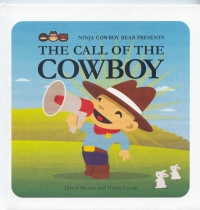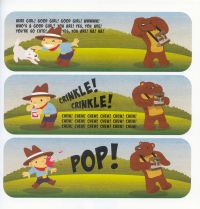| ________________
CM . . . . Volume XVIII Number 15 . . . . December 9, 2011

 |
Ninja Cowboy Bear Presents The Call of the Cowboy.
David Bruins & Hilary Leung.
Toronto, ON: Kids Can Press, 2011.
32 pp., hardcover, $16.95.
ISBN 978-1-55453-748-8.
Kindergarten-grade 2 / Ages 5-7.
Review by Ellen Wu.
**1/2 /4
|
| |
|

excerpt:
The cowboy was a good friend to the ninja and bear. He was kind. He was caring. He was fun. He was funny, But sometimes he could cause a ruckus. One day his noisiness came between him and his friends.....And here is what happened.
David Bruins and Hilary Leung add a third adventure to their “Ninja Cowboy Bear” series which first launched in 2009 with The Legend of Ninja Cowboy Bear and followed by 2010’s The Way of the Ninja. In this installment, the strengths of the story remain the same as do its potential weaknesses. Leung’s illustrations leap off the page with their cartoony verve and bright colour palette, a style that brings to mind the mascots from the 2010 Vancouver Olympics. Sadly, the actual story does not quite live up to the fun factor of the illustrations.
The Call of the Cowboy begins with the preamble excerpted above as readers are told that Cowboy’s noisiness is not always welcome amongst his friends. Bear wants to photograph birds, but Cowboy’s incessant chewing, crinkling of bubblegum wrappers, and boinging on a pogo stick distract him. Bear leaves but first “told the cowboy that it was not a good day for photographs.” Cowboy then pays Ninja a visit. Ninja is reading a book under a tree (metafictive moment here: he’s reading the prequels to the current book being reviewed!). Again, Cowboy alienates poor Ninja by gabbing on the cell phone, snoring, and other rambunctious behaviours. Ninja excuses himself from Cowboy’s obnoxious presence by saying that “his book was not very interesting.” Both these incidents are portrayed through a double page spread, with one page using three panelled illustrations, like a comic strip, to show Cowboy’s distracting behaviours, complete with sound effects text like tippity tap and BOING BOING, while the other page features a close-up of Cowboy being abandoned by his friend.
 Cowboy wants to know why he’s hurt his friends, Ninja and Bear, but “he could not concentrate” because of the racket all around him. When he finally reaches a spot of calm in the busy park, “Cowboy understood perfectly” that sometimes his friends want peace and quiet too. Their friendship is renewed, and they go off on adventures together, with the last page showing Ninja and Bear snoring soundly like buzz saws, while Cowboy, in a comic touch of poetic justice, is kept awake by their racket.
Cowboy wants to know why he’s hurt his friends, Ninja and Bear, but “he could not concentrate” because of the racket all around him. When he finally reaches a spot of calm in the busy park, “Cowboy understood perfectly” that sometimes his friends want peace and quiet too. Their friendship is renewed, and they go off on adventures together, with the last page showing Ninja and Bear snoring soundly like buzz saws, while Cowboy, in a comic touch of poetic justice, is kept awake by their racket.
Previous reviewers of this series on CM have noted the obvious didacticism of the stories, and the inexplicability of why the three were friends in the first place. While I don’t find the oddball arbitrariness of the trio being thrown together too problematic, I do agree with the assessment that the moralizing is a bit forced: Ninja and Bear’s characterization is nowhere as developed as Cowboy’s as they are vehicles to teach a lesson rather than full-fledged personalities. As a read-aloud for a class, the book’s formal language is at odds with the style of the illustrations and may fall flat for some audiences. For example: “Then the cowboy asked his friends if they would accompany him in song” could easily have been a dialogue exchange among the three. There is so much potential for “Show, don’t tell!” in this book that is lost through the text, which leads me to consider why dialogue bubbles are not employed through the entire story, a la Mo Willems’s “Elephant & Piggy” stories. The book’s smaller size does suit a one-on-one lap read with a child and prompts discussion about how to be sensitive to the needs of one's friends. Finally, a minor quibble: The Call of the Cowboy as a title is a little misleading; Cowboy is noisy, but he doesn’t have a signature call.
As it stands, Ninja Cowboy Bear’s latest adventure still holds a strong visual appeal for youngsters. Sharing the story with children with some extemporised dialogue and dramatic performance of the sound effects may offset the moralizing element of the narrative itself. NCB has a lot of potential, with its instantly recognisable characters and online activities from the authors’ joint website (http://www.ninjacowboybear.com), and so I look forward to where the author-illustrator team of Bruins and Leung take readers next with these three friends.
Recommended.
Ellen Wu holds a MFA in children’s literature from Hollins University, and will soon graduate with a MLIS from the University of British Columbia.

To comment
on this title or this review, send mail to cm@umanitoba.ca.
Copyright © the Manitoba Library Association. Reproduction for personal
use is permitted only if this copyright notice is maintained. Any
other reproduction is prohibited without permission.
NEXT REVIEW |
TABLE OF CONTENTS FOR THIS ISSUE
- December 9, 2011.
AUTHORS |
TITLES |
MEDIA REVIEWS |
PROFILES |
BACK ISSUES |
SEARCH |
CMARCHIVE |
HOME |

 Cowboy wants to know why he’s hurt his friends, Ninja and Bear, but “he could not concentrate” because of the racket all around him. When he finally reaches a spot of calm in the busy park, “Cowboy understood perfectly” that sometimes his friends want peace and quiet too. Their friendship is renewed, and they go off on adventures together, with the last page showing Ninja and Bear snoring soundly like buzz saws, while Cowboy, in a comic touch of poetic justice, is kept awake by their racket.
Cowboy wants to know why he’s hurt his friends, Ninja and Bear, but “he could not concentrate” because of the racket all around him. When he finally reaches a spot of calm in the busy park, “Cowboy understood perfectly” that sometimes his friends want peace and quiet too. Their friendship is renewed, and they go off on adventures together, with the last page showing Ninja and Bear snoring soundly like buzz saws, while Cowboy, in a comic touch of poetic justice, is kept awake by their racket.